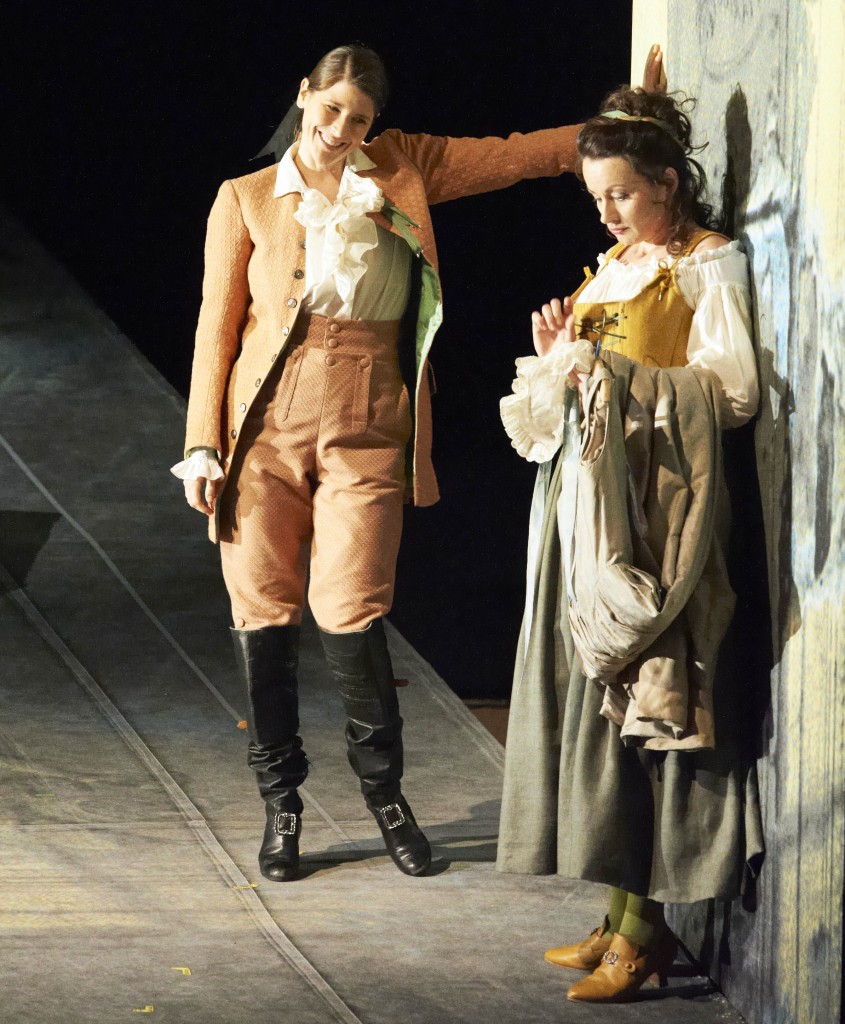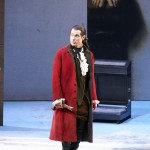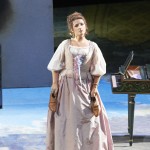 Le Nozze di Figaro , like any great work of art, defies any single interpretation. Mozart and librettist Da Ponte’s opera, premiered in 1786, was initially censored by Vienna’s Court as socially subversive: Count Almaviva, a womaniser, and serial seducer of his servants has his come-uppance plotted by his valet, his wife, and his household. Set around the 1780s in Almaviva’s castle, the Count, supposedly an advocate of ‘Enlightenment’, waives his seigneural right of primae noctis. Except for Susanna, the Countess’s maid, the intended bride of Figaro. The Count, with designs on Susanna, offers Susanna and Figaro a room in the seigneural wing, and contrives to postpone the wedding. The ensuing intrigues, the Count besieged in his own Castle, could be an allegory for the Revolution to sweep Europe.
Le Nozze di Figaro , like any great work of art, defies any single interpretation. Mozart and librettist Da Ponte’s opera, premiered in 1786, was initially censored by Vienna’s Court as socially subversive: Count Almaviva, a womaniser, and serial seducer of his servants has his come-uppance plotted by his valet, his wife, and his household. Set around the 1780s in Almaviva’s castle, the Count, supposedly an advocate of ‘Enlightenment’, waives his seigneural right of primae noctis. Except for Susanna, the Countess’s maid, the intended bride of Figaro. The Count, with designs on Susanna, offers Susanna and Figaro a room in the seigneural wing, and contrives to postpone the wedding. The ensuing intrigues, the Count besieged in his own Castle, could be an allegory for the Revolution to sweep Europe.
But the opera is ‘never only one thing’. The intrigues and counterplotting are about love, the characters are in a war of the sexes; Mozart and Da Ponte’s concern is with fidelity, and the tragi-comic consequences of misplaced trust and adultery. So the Countess’s arias are heartrending, as Act 2, ‘what happened to the those moments of joy; where are all those promises that passed his dying lips.’ Whereas the men are, to us, mysoginists. Figaro, Act 4, seeing his Susanna (the Countess disguised) engaging with the Count, decries ‘open your eyes…see women as they are.’ The closure celebrates the convention of marriage, but is problematical. The Count begs the Countess’s forgiveness; she does so because ‘she is more understanding.’
I was over-critical of Jean-Lous Martinoty’s production, then ‘new’ in 2012. Those cardboard cut-outs and trompe l’oeuil screens -a collage of cultural references- are problematic; but not distracting. This production is outstanding, a near ideal cast. Luca Pisaroni’s Figaro is a stalwart baritone, but at first lacking flexibility, not quite a figure of fun. His Act 1 aria challenges his master, ‘If Almaviva wants to play tricks scheming for Susanna, then he’ll outsmart him.’ Maybe Pisaroni’s too straight, not mischevious enough? Figaro, in a mustard frock coat, wants to know everything from Susanna (Anna Hartig): ‘Do you think he gives us a dowry for nothing…The count abolished his seigneural right- now he revokes it.’
The surprise was Simon Keenlyside’s Almaviva, who first appears looking quite raunchy. His hair is swept back in a tail, his billowing white shirt open, his gold breeches tucked into knee-length boots. Not the stuffed -shirt you’d expect fot a Count. And after so many dramatic Verdian roles, baritone Keenlyside shows a natural flair for comedy. Almaviva is forever being outwitted by his servants, especially his page Cherubino. So in Act 1, Almaviva enters -Cherubino hidden behind an armchair – while the Count ardently woos Susanna. Almaviva hides, hearing music master Basilio; but emerges furious at the revelation of Cherubino’s passion for the Countess. Almaviva uncovers the elusive Cherubino under a blanket, Cherubino ‘at it again’. But Almaviva having expelled Cherubino, realises his page overheard his play for Susanna. Finally Figaro enters with a group of peasants to ask for the wedding date, singing ‘We scatter flowers before our noble lord for abandoning his seugeurial rights’. The Chorus are continually mocking their Seigneur.
Olga Bezsmertina sings the Countess. In her aria (opening Act 2) Porgi, amor, qualche ristore, ‘Oh, give me consolation, my beloved back or let me die’, sings to an interweaving clarinet solo. Dressed in a lilac gown, kneeling on silk cushions, her auburn hair coiffured, Bezsmertina’s glorious soprano is refined, cultivated, high range not strained.
In Figaro’s intrigue- Pisaroni better, more the schemer- Susanna will agree to meet the Count in the garden: but it’s actually Cherubino in Susanna’s gown, so the Countess can expose her husband. In Cherubino’s aria ‘You ladies who know what love is, tell me if I have it in my heart’, (Voi, che sapete che cosa e amor), the irony is that Cherubino is sung by a woman (Rachel Frenkel) cross-dressed . ‘I freeze, I burn, and then I freeze again.’ The sentiment is at the heart of the opera’s engagement with the pain and pleasure of love. ‘Without wishing I tremble, I find no peace.’ In this iconic aria, Frenkel is bland, passionless, routine, although it’s well sung. It’s superficially beautiful, so Susanna comments, ‘Bravo, che bella voce!’ I didn’t know he could sing so well.’ (More dramatic irony.) ‘What to do with his hair: fetch one of my bonnets’. Cherubino is now dressed as a cute-looking maid. Mozart’s is opera buffa after all.
 Almaviva knocks furiously (the frightened page locked in a closet). Wow! Keenlyside’s Almaviva, sleeked- black hair, in a louche scarlet frock coat, rouched white lace, black boots- a touch of Dracula. Keenlyside is excellent at pointing up the comedy, his rage and petulance rather ridiculous. He’s a figure of lust, denied, defied!
Almaviva knocks furiously (the frightened page locked in a closet). Wow! Keenlyside’s Almaviva, sleeked- black hair, in a louche scarlet frock coat, rouched white lace, black boots- a touch of Dracula. Keenlyside is excellent at pointing up the comedy, his rage and petulance rather ridiculous. He’s a figure of lust, denied, defied!
Keenlyside and Bezsmertina are first class in their fiery duet. ‘I’d go through hell for her,’ sings the the Count ironically. (Susanna is hidden behind an easel.) Keenlyside stamps his feet with rage, ‘Come out you scoundrel.’ By which time Cherubino has escaped, now dressed as a young cavalier. With cruel irony, Almaviva, the philanderer, tells the Countess to get out of his sight,’You disgrace me.’
The closet empty -Susanna emerges sweet- and- innocent -Almaviva has to apologise. The Countess reproaches him ,’You’re lying. I’m the woman who deceives you- Rosina- cruel man !’ (She’s Rosina, once the ward of Doctor Bartolo, whom Figaro abducted for Almaviva.) Now Countess, she sings passionately ‘Who would believe in a woman’s fury!’ She counters, my heart will try to understand you. Mozart/Da Ponte- within the apparent farce- are offering a very modern psychological realism of a marriage on the rocks.
The quartet comprises the servants Figaro and Susanna in mustard and grey, the Royals in red and lilac. As in theatre, it will end happily with a wedding, sing the Chorus ironically.
In Almaviva’s (Act 3) assignation with Susanna, she entices him into the garden. ‘Forgive me if I lie, but such is the nature of love.’ Keenlyside’s Almaviva is a figure of fun; the Count powerless, his Castle out of control. In his powerful aria, he realises he’s caught in a trap. But is he supposed to suffer and see his servant happy after she’s rejected his advances? ‘I’ll leave you no place; you were not born to torment me.’ There were cheers for Keenlyside, deservedly applauded.
‘Why does the memory of happiness linger on’, an oboe laces the Countess’s plaintive aria. ‘Ah, if I could hope to change his ungrateful heart.’ Bezsmertina, in a pink white dress, trimmed in gold, was superlative.
‘Soft Zepphyr will await the evening..’ The Countess conspires to win back her husband. Susanna agrees to the Count’s rendezvous. But Susanna appears dressed as the Countess, while the Count seduces his own wife dressed as Susanna. It’s comedy, but cruel and cynical; and for the Countess, desperate. So the Chorus’ (end Act 3) refrain ‘Amanti constanti…Andante, amici’, Faithful lovers sing the Lord’s praises, has added resonnance.
Figaro, unaware of the switch, sees Almaviva apparently with Susanna . His bitterly mysoginistic aria, Tutti e disposto ‘Allow us to suffer sirens…’ sung feistily by Pisaroni, but not at all comic. It accords with the dark undercurrent to this opera buffa.
Reunited with Figaro, Anita Hartig in Susanna’s aria is a high point. ‘Deh, vieni, non tardar’ . At last the moment…Oh, wonderful joy. Hartig is powerful, moving, ‘Come my beloved to my hiding place; she will place a wreath of roses on his brow. (The rose-printed screen is very effective.)
Their aristocratic counterparts are more problematic. In the charade the Count gropes at the disguised- as- Susanna Countess- who plays along with her husband’s fantasies. Keenlyside and Beszmertina enact the scene with spontaneous naturalness. She will trap the villain; he thinks her a cunning vixen’s heart. (She’s absolutely furious.) He, ‘Let us not lose any time’, Almaviva aroused with adulterous passion. But with her disguise revealed, she sits astride him: he’s trapped . On his knees he craves her forgiveness. She, ‘more understanding’, will have him back, knowing perhaps he’ll relapse.
Only love can end this day of mad intrigue, sing the Chorus, Hasten the fesivities, corriera tutti a festeggia. The ensemble’s ‘Then let us all be happy’ is ambivalent. Rather the convention of marriage, as closure, patches up lovers’ jealousies, matrimonial discord: the feel -good factor.
Keenlyside, Bezsmertina and Hartig especially underpin an outstanding production, with sympathetic playing from Vienna State Opera Orchestra and Chorus under Jeremie Rhorer. P.R. 9.1.2014
Photos: Rachel Frenkel (Cherubino) and Anita Hartig (Susanna); Simon Keenlyside (Almaviva); Olga Bezsmertina (Countess Almaviva)
(c) Wiener Staatsoper/ Michael Pöhn
viennaoperareview.com
Vienna's English opera blog
